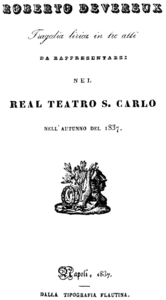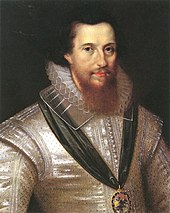Roberto Devereux
| Work data | |
|---|---|
| Title: | Roberto Devereux |

Title page of the libretto, Naples 1837 |
|
| Shape: | Opera seria in three acts |
| Original language: | Italian |
| Music: | Gaetano Donizetti |
| Libretto : | Salvadore Cammarano |
| Premiere: | October 29, 1837 |
| Place of premiere: | Teatro San Carlo , Naples |
| Playing time: | approx. 2 ¼ hours |
| Place and time of the action: | London, 1601 |
| people | |
|
|
Roberto Devereux is a three-act opera seria (original name: "tragedia lirica"), by Gaetano Donizetti based on a libretto by Salvadore Cammarano . The literary basis is the tragedy by Jacques-François Ancelot , Elisabeth d'Angleterre . The opera's premiere took place on October 29, 1837 at the Teatro San Carlo in Naples . After Anna Bolena (1830) and Maria Stuarda (1835), Roberto Devereux is the third and last of Donizetti's so-called Tudor operas .
action

The plot of the opera is based freely on the so-called Essex Rebellion under Robert Devereux, the Earl of Essex , and is set in London in 1601.
first act
Elisabetta tells her friend Sara that she wants to save Roberto Devereux, her favorite, from being charged with high treason - provided she can be sure of his love (“Ritorna qual ti spero”). She does not know that Sara, for her part, loves Roberto, whose best friend, Nottingham, was married to the Queen against her will. When Lord Cecil appears with the death sentence for Roberto, Elisabetta refuses to sign it because her guilt has not been proven. In a discussion with Roberto, Elisabetta reminds him on the one hand of her love, on the other hand of the ring that she once gave him and that is supposed to save him from every danger. But Roberto betrays himself and arouses Elisabetta's anger through this betrayal. Then the Duke of Nottingham appears, disturbed by his wife's strange behavior. He promises help to the friend. Lord Cecil brings the death sentence. Roberto rushes to Sara and blames her for marrying Nottingham. However, both realize that they still love each other. Sara urges him to flee and gives him an embroidered scarf as a pledge of love to take with him. For his part, Roberto leaves Elisabetta's ring with her (“Quest'addio fatale, estremo”).
Second act
Elisabetta learns of the death sentence. Sir Raleigh reports that an embroidered scarf was found when Roberto was arrested. Nottingham signs the death sentence for the queen, but tries to speak one last time for the friend. Roberto appears; Elisabetta shows him the scarf and both men freeze: The proof of infidelity. Nottingham immediately wants to raise its hand against the friend, but Elisabetta offers Roberto his freedom for the name of the lover one last time. Roberto prefers death and the Queen signs the death sentence ("Va '! Va', la morte sul capo ti pende").
Third act
Sara receives a letter from Roberto asking her to bring the ring to the queen and use it to save his life. Just as Sara is about to run away, Nottingham appears and accuses her of being unfaithful. When he learns what she is up to, he locks her in the house until she is executed. Roberto hopes to be saved in the dungeon: he wants to restore Sara's honor and then perish at Nottingham's hand (“Bagnato il sen di lagrime”). Elisabetta struggles with her feelings. In the meantime she has decided to let Roberto go with her lover. At the moment when Roberto is being led to the execution, Sara appears with the ring and confesses to the queen that she is the mistress herself. Then Elisabetta orders that the execution be postponed. But too late. A cannon shot heralds what Nottingham says: Roberto's death. As a broken woman, Elisabetta proclaims her resignation from the throne ("Non regno! Non vivo!"), Hands over the insignia of her power to her nephew James, the King of Scotland, and collapses ("Qual sangue versato al cielo").
orchestra
The orchestral line-up for the opera includes the following instruments:
- Woodwinds : two flutes (2nd also piccolo ), two oboes , two clarinets , two bassoons
- Brass : four horns , two trumpets , three trombones
- Timpani , bass drum
- Strings
Work history

At the premiere on October 29, 1837, Donizetti's favorite singer Giuseppina Ronzi de Begnis sang the particularly demanding role and actual leading role of Queen Elisabeth and Giovanni Basadonna the title role of Roberto Devereux, in other roles were Paul Barroilhet as Nottingham, Almerinda Manzocchi Granchi as Sara, Timoleone Barattini as Lord Cecil, Anafesto Rossi as Gualtiero Raleigh and Giuseppe Benedetti as a page. The conductor was Nicola Festa . The sets were by Raffaele Mattioli, Nicola "Nicoletto" Pellandi and Antonio Niccolini.
The opera has been performed repeatedly over the past few decades: in 1965 Montserrat Caballé sang a concert performance in New York, in 1970 Beverly Sills sang with Plácido Domingo at NYCO, and in 1977 Caballé sang again with José Carreras at the Aix-en-Provence Festival .
Since 1990 Edita Gruberová has performed at the Gran Teatro del Liceu in Barcelona under Richard Bonynge and in 1997 at the Zurich Opera House . Alternating with Silvana Dussmann , she has been singing in historic performances at the Vienna State Opera since 2000 , and since 2004 in the modern production by Christof Loy at the Bavarian State Opera in Munich.
In the 2015/2016 season the opera was newly staged at the Metropolitan Opera, New York under Maurizio Benini with Sondra Radvanovsky as Elisabeth.
Significant recordings
- with Beverly Sills (Elisabeth), Róbert Ilosfalvy (Roberto Devereux), Peter Glossop (Nottingham), Beverly Wolff (Sara) u. a., Ambrosian Opera Chorus, Royal Philharmonic Orchestra , Charles Mackeras , Deutsche Grammophon, 1969.
- with Edita Gruberová (Elisabeth), Don Bernardini (Roberto Devereux), Delores Ziegler (Sara), Ettore Kim (Nottingham) u. a., Choeurs de l'Opéra du Rhin, Orchester Philharmonique de Strasbourg, Friedrich Haider , Nightingale Classics, 1994.
Web links
- Roberto Devereux : Sheet music and audio files in the International Music Score Library Project
- Libretto (Italian), Naples 1837. Digitized version of the Munich digitization center
- Work information and libretto (Italian) as full text on librettidopera.it
- Roberto Devereux, o Il conte d'Essex (Gaetano Donizetti) in the Corago information system of the University of Bologna
- Plot and libretto of it at Opera Guide landing page for URL upgrade currently unavailable
- Discography on Roberto Devereux at Operadis
Individual evidence
- ^ Norbert Miller : Roberto Devereux ossia Il conte di Essex. In: Piper's Encyclopedia of Musical Theater . Volume 2: Works. Donizetti - Henze. Piper, Munich / Zurich 1987, ISBN 3-492-02412-2 , pp. 14-18.
- ↑ October 29, 1837: “Roberto Devereux”. In: L'Almanacco di Gherardo Casaglia ., Accessed on August 8, 2019.
- ↑ Roberto Devereux's performance dates at the Vienna State Opera , accessed on July 24, 2019.